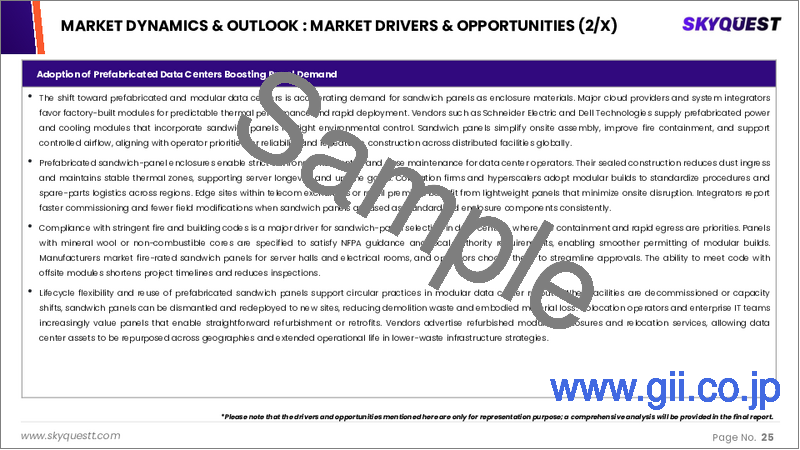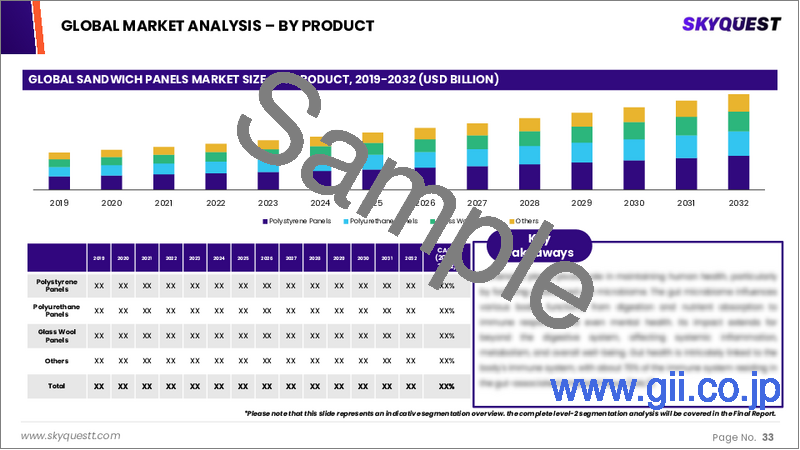|
|
市場調査レポート
商品コード
1666058
サンドイッチパネル市場規模、シェア、成長分析:製品別、用途別、スキン素材別、最終用途別、地域別 - 産業予測 2025~2032年Sandwich Panels Market Size, Share, and Growth Analysis, By Product (Polystyrene Panels, Polyurethane Panels), By Application (Walls & Floors, Roofs), By Skin Material, By End-use, By Region - Industry Forecast 2025-2032 |
||||||
|
|||||||
| サンドイッチパネル市場規模、シェア、成長分析:製品別、用途別、スキン素材別、最終用途別、地域別 - 産業予測 2025~2032年 |
|
出版日: 2025年02月26日
発行: SkyQuest
ページ情報: 英文 161 Pages
納期: 3~5営業日
|
全表示
- 概要
- 目次
サンドイッチパネル市場規模は2023年に82億米ドルと評価され、2024年の88億1,000万米ドルから2032年には157億2,000万米ドルに成長し、予測期間(2025-2032年)のCAGRは7.5%で成長する見通しです。
世界のサンドイッチパネル市場は、商業および建設分野で極めて重要な市場であり、消費者の嗜好の変化、技術の進歩、環境意識の高まりに起因する顕著なシフトを経験しています。これらの軽量で耐久性のあるパネルは、特にその強度と、成長しつつある無血収納部門を含む様々な用途における汎用性により、従来の素材に取って代わる傾向が強まっています。接着技術や芯材における革新は、エンドユーザーに多様なカスタマイズオプションを提供し、サンドイッチパネルを、優れた断熱性を必要とする倉庫や冷蔵車などの温度に敏感な環境に理想的なものにしています。持続可能で費用対効果の高い建築ソリューションへの需要が高まる中、サンドイッチパネル市場は、業界の持続可能性目標に沿った環境に優しい製造方法と素材への取り組みにより、大きな成長を遂げようとしています。
目次
イントロダクション
- 調査の目的
- 調査範囲
- 定義
調査手法
- 情報調達
- 二次と一次データの方法
- 市場規模予測
- 市場の前提条件と制限
エグゼクティブサマリー
- 世界市場の見通し
- 供給と需要の動向分析
- セグメント別機会分析
市場力学と見通し
- 市場概要
- 市場規模
- 市場力学
- 促進要因と機会
- 抑制要因と課題
- ポーターの分析
主な市場の考察
- 重要成功要因
- 競合の程度
- 主な投資機会
- 市場エコシステム
- 市場の魅力指数(2024年)
- PESTEL分析
- マクロ経済指標
- バリューチェーン分析
- 価格分析
- ケーススタディ
- 顧客と購買基準の分析
サンドイッチパネル市場規模:製品別& CAGR(2025-2032)
- 市場概要
- ポリスチレンパネル
- ポリウレタンパネル
- グラスウールパネル
- その他
サンドイッチパネル市場規模:用途別& CAGR(2025-2032)
- 市場概要
- 壁と床
- 屋根
- 冷蔵
サンドイッチパネル市場規模:スキン素材別& CAGR(2025-2032)
- 市場概要
- 連続繊維強化熱可塑性プラスチック(CFRT)
- グラスファイバー強化パネル(FRP)
- アルミニウム
- 鋼鉄
- その他
サンドイッチパネル市場規模:最終用途別& CAGR(2025-2032)
- 市場概要
- 住宅用
- 非住宅
サンドイッチパネル市場規模:地域別& CAGR(2025-2032)
- 北米
- 米国
- カナダ
- 欧州
- ドイツ
- スペイン
- フランス
- 英国
- イタリア
- その他欧州地域
- アジア太平洋地域
- 中国
- インド
- 日本
- 韓国
- その他アジア太平洋地域
- ラテンアメリカ
- ブラジル
- その他ラテンアメリカ地域
- 中東・アフリカ
- GCC諸国
- 南アフリカ
- その他中東・アフリカ
競合情報
- 上位5社の比較
- 主要企業の市場ポジショニング(2024年)
- 主な市場企業が採用した戦略
- 最近の市場動向
- 企業の市場シェア分析(2024年)
- 主要企業の企業プロファイル
- 企業の詳細
- 製品ポートフォリオ分析
- 企業のセグメント別シェア分析
- 収益の前年比比較(2022-2024)
主要企業プロファイル
- ArcelorMittal(Luxembourg)
- Kingspan Group(Ireland)
- BASF(Germany)
- Nucor Corporation(United States)
- Tata Steel(India)
- Metecno(Italy)
- Isopan(Italy)
- PPG Industries(United States)
- SchworerHaus(Germany)
- Sips Panels Ltd(United Kingdom)
- Uralita(Spain)
- Changzhou Jiasheng Building Materials(China)
- Jiangsu Zhongtai Steel Structure(China)
- The Manse Group(United Kingdom)
結論と提言
Sandwich Panels Market size was valued at USD 8.2 billion in 2023 and is poised to grow from USD 8.81 billion in 2024 to USD 15.72 billion by 2032, growing at a CAGR of 7.5% during the forecast period (2025-2032).
The global sandwich panels market, pivotal in the commercial and construction sectors, is experiencing notable shifts attributed to changing consumer preferences, technological advancements, and eco-consciousness. These lightweight, durable panels are increasingly replacing traditional materials, particularly due to their strength and versatility in various applications, including the growing bloodless storage sector. Innovations in bonding techniques and core materials offer end users diverse customization options, making sandwich panels ideal for temperature-sensitive environments like warehouses and refrigerated vehicles, which require excellent thermal insulation. As demand for sustainable and cost-effective building solutions rises, the sandwich panels market is poised for significant growth, driven by a commitment to environmentally friendly manufacturing practices and materials that align with the industry's sustainability goals.
Top-down and bottom-up approaches were used to estimate and validate the size of the Sandwich Panels market and to estimate the size of various other dependent submarkets. The research methodology used to estimate the market size includes the following details: The key players in the market were identified through secondary research, and their market shares in the respective regions were determined through primary and secondary research. This entire procedure includes the study of the annual and financial reports of the top market players and extensive interviews for key insights from industry leaders such as CEOs, VPs, directors, and marketing executives. All percentage shares split, and breakdowns were determined using secondary sources and verified through Primary sources. All possible parameters that affect the markets covered in this research study have been accounted for, viewed in extensive detail, verified through primary research, and analyzed to get the final quantitative and qualitative data.
Sandwich Panels Market Segments Analysis
Global Sandwich Panels Market is segmented by Product, Application, Skin Material, End-use and region. Based on Product, the market is segmented into Polystyrene Panels, Polyurethane Panels, Glass Wool Panels and Others. Based on Application, the market is segmented into Walls & Floors, Roofs and Cold Storage. Based on Skin Material, the market is segmented into Continuous Fibre Reinforced Thermoplastics (CFRT), Fibreglass Reinforced Panel (FRP), Aluminum, Steel and Others. Based on End-use, the market is segmented into Residential and Non-residential. Based on region, the market is segmented into North America, Europe, Asia Pacific, Latin America and Middle East & Africa.
Driver of the Sandwich Panels Market
The growing demand for sandwich panels is largely driven by their exceptional insulation properties and the rising global consciousness surrounding environmental sustainability and energy efficiency. These panels are particularly favored in commercial, industrial, and residential construction projects, primarily because they contribute to reduced heating and cooling expenses. As businesses and homeowners alike seek energy-efficient solutions to lower operational costs and minimize their ecological footprint, sandwich panels emerge as an ideal choice. Their ability to enhance energy conservation aligns with the increasing focus on sustainable building practices, further fueling their market growth in various construction applications.
Restraints in the Sandwich Panels Market
A significant restraint on the growth of the sandwich panels market is the limited awareness in emerging economies regarding their benefits, such as energy efficiency and durability. Many individuals in these regions lack knowledge about sandwich panels, leading to a preference for conventional construction methods, perceived as more familiar and cost-effective. This lack of understanding prevents potential users from exploring and adopting sandwich panels, ultimately hindering the market's expansion in these areas. As a result, the industry faces challenges in penetrating these markets, which slows the overall growth and acceptance of sandwich panel technology despite its advantages.
Market Trends of the Sandwich Panels Market
The Sandwich Panels market is witnessing a robust upward trend driven by the surging demand for energy-efficient building solutions. As sustainability becomes a paramount concern across industries, the adoption of sandwich panels-renowned for their exceptional thermal insulation properties-has soared. This surge is particularly notable in the commercial and residential sectors as stringent regulations on energy efficiency propel developers and builders to prioritize sustainable materials. These panels not only contribute to substantial reductions in energy consumption but also align with the broader global transition towards greener building practices. Consequently, this trend underscores a strong market potential for sandwich panels, appealing to environmentally conscious stakeholders.
Table of Contents
Introduction
- Objectives of the Study
- Scope of the Report
- Definitions
Research Methodology
- Information Procurement
- Secondary & Primary Data Methods
- Market Size Estimation
- Market Assumptions & Limitations
Executive Summary
- Global Market Outlook
- Supply & Demand Trend Analysis
- Segmental Opportunity Analysis
Market Dynamics & Outlook
- Market Overview
- Market Size
- Market Dynamics
- Drivers & Opportunities
- Restraints & Challenges
- Porters Analysis
- Competitive rivalry
- Threat of substitute
- Bargaining power of buyers
- Threat of new entrants
- Bargaining power of suppliers
Key Market Insights
- Key Success Factors
- Degree of Competition
- Top Investment Pockets
- Market Ecosystem
- Market Attractiveness Index, 2024
- PESTEL Analysis
- Macro-Economic Indicators
- Value Chain Analysis
- Pricing Analysis
- Case Studies
- Customer And Buying Criteria Analysis
Global Sandwich Panels Market Size by Product & CAGR (2025-2032)
- Market Overview
- Polystyrene Panels
- Polyurethane Panels
- Glass Wool Panels
- Others
Global Sandwich Panels Market Size by Application & CAGR (2025-2032)
- Market Overview
- Walls & Floors
- Roofs
- Cold Storage
Global Sandwich Panels Market Size by Skin Material & CAGR (2025-2032)
- Market Overview
- Continuous Fibre Reinforced Thermoplastics (CFRT)
- Fibreglass Reinforced Panel (FRP)
- Aluminum
- Steel
- Others
Global Sandwich Panels Market Size by End-use & CAGR (2025-2032)
- Market Overview
- Residential
- Non-residential
Global Sandwich Panels Market Size & CAGR (2025-2032)
- North America (Product, Application, Skin Material, End-use)
- US
- Canada
- Europe (Product, Application, Skin Material, End-use)
- Germany
- Spain
- France
- UK
- Italy
- Rest of Europe
- Asia Pacific (Product, Application, Skin Material, End-use)
- China
- India
- Japan
- South Korea
- Rest of Asia-Pacific
- Latin America (Product, Application, Skin Material, End-use)
- Brazil
- Rest of Latin America
- Middle East & Africa (Product, Application, Skin Material, End-use)
- GCC Countries
- South Africa
- Rest of Middle East & Africa
Competitive Intelligence
- Top 5 Player Comparison
- Market Positioning of Key Players, 2024
- Strategies Adopted by Key Market Players
- Recent Developments in the Market
- Company Market Share Analysis, 2024
- Company Profiles of All Key Players
- Company Details
- Product Portfolio Analysis
- Company's Segmental Share Analysis
- Revenue Y-O-Y Comparison (2022-2024)
Key Company Profiles
- ArcelorMittal (Luxembourg)
- Company Overview
- Business Segment Overview
- Financial Updates
- Key Developments
- Kingspan Group (Ireland)
- Company Overview
- Business Segment Overview
- Financial Updates
- Key Developments
- BASF (Germany)
- Company Overview
- Business Segment Overview
- Financial Updates
- Key Developments
- Nucor Corporation (United States)
- Company Overview
- Business Segment Overview
- Financial Updates
- Key Developments
- Tata Steel (India)
- Company Overview
- Business Segment Overview
- Financial Updates
- Key Developments
- Metecno (Italy)
- Company Overview
- Business Segment Overview
- Financial Updates
- Key Developments
- Isopan (Italy)
- Company Overview
- Business Segment Overview
- Financial Updates
- Key Developments
- PPG Industries (United States)
- Company Overview
- Business Segment Overview
- Financial Updates
- Key Developments
- SchworerHaus (Germany)
- Company Overview
- Business Segment Overview
- Financial Updates
- Key Developments
- Sips Panels Ltd (United Kingdom)
- Company Overview
- Business Segment Overview
- Financial Updates
- Key Developments
- Uralita (Spain)
- Company Overview
- Business Segment Overview
- Financial Updates
- Key Developments
- Changzhou Jiasheng Building Materials (China)
- Company Overview
- Business Segment Overview
- Financial Updates
- Key Developments
- Jiangsu Zhongtai Steel Structure (China)
- Company Overview
- Business Segment Overview
- Financial Updates
- Key Developments
- The Manse Group (United Kingdom)
- Company Overview
- Business Segment Overview
- Financial Updates
- Key Developments






